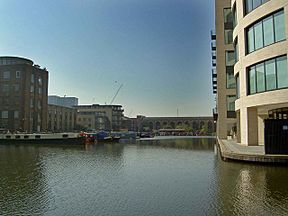Battlebridge Basin facts for kids
Quick facts for kids Battlebridge Basin |
|
|---|---|

Battlebridge Basin from the main canal
|
|
| Specifications | |
| Status | Open |
| Navigation authority | Canal & River Trust |
| History | |
| Date completed | 1822 |
Battlebridge Basin is a special canal basin found in the London Borough of Islington. It is a quiet spot located just off the main Regent's Canal. A canal basin is like a wide parking area for boats, allowing them to turn around or stop for a while.
What is Battlebridge Basin Used For Today?
Today, Battlebridge Basin is a lively place. Many boats are moored here, and some people even live on them! These are called residential moorings.
The basin is also home to the London Canal Museum. This museum opened in 1992. It teaches visitors all about the history of London's canals. You can learn how canals were used to transport goods long ago.
Another important building here is Kings Place. This large building was finished in 2008. It is a center for music, art, and events. It is also where the offices for The Guardian newspaper are located. The basin itself is about 140 metres (460 ft) long and 50 metres (160 ft) wide.
A Look Back: The History of Battlebridge Basin
Battlebridge Basin was built a long time ago, in 1820. It was created at the same time as the second part of the Regent's Canal. This part of the canal stretched from Camden Town to Limehouse. The buildings around the basin, called wharf buildings, were finished a little later, in 1822.
The basin has had a few different names over the years. At first, it was known as Horsfall Basin. This name came from the person who owned the land originally. Later, it was called Maiden Lane Basin. Its current name, Battlebridge Basin, comes from an old name for the King's Cross area. This area was named after an ancient bridge that crossed the River Fleet.
In the past, the buildings where the canal museum now stands had a very cool use. During the late 1800s and early 1900s, they were used to store ice! This ice was brought all the way from Norway. It was then distributed to homes and businesses in the area.

